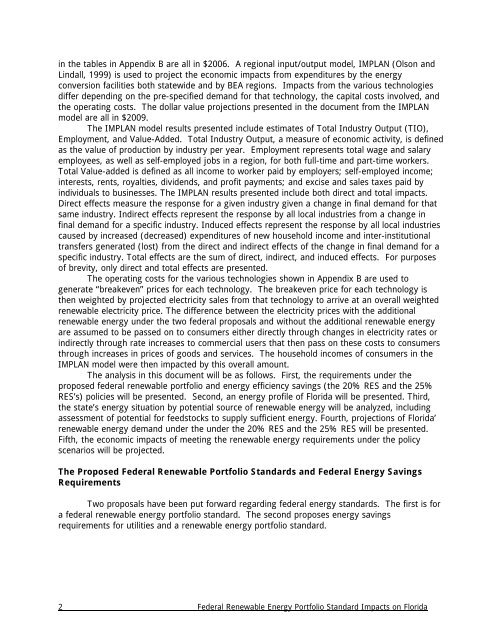Florida Study - Bipartisan Policy Center
Florida Study - Bipartisan Policy Center
Florida Study - Bipartisan Policy Center
Create successful ePaper yourself
Turn your PDF publications into a flip-book with our unique Google optimized e-Paper software.
in the tables in Appendix B are all in $2006. A regional input/output model, IMPLAN (Olson andLindall, 1999) is used to project the economic impacts from expenditures by the energyconversion facilities both statewide and by BEA regions. Impacts from the various technologiesdiffer depending on the pre-specified demand for that technology, the capital costs involved, andthe operating costs. The dollar value projections presented in the document from the IMPLANmodel are all in $2009.The IMPLAN model results presented include estimates of Total Industry Output (TIO),Employment, and Value-Added. Total Industry Output, a measure of economic activity, is definedas the value of production by industry per year. Employment represents total wage and salaryemployees, as well as self-employed jobs in a region, for both full-time and part-time workers.Total Value-added is defined as all income to worker paid by employers; self-employed income;interests, rents, royalties, dividends, and profit payments; and excise and sales taxes paid byindividuals to businesses. The IMPLAN results presented include both direct and total impacts.Direct effects measure the response for a given industry given a change in final demand for thatsame industry. Indirect effects represent the response by all local industries from a change infinal demand for a specific industry. Induced effects represent the response by all local industriescaused by increased (decreased) expenditures of new household income and inter-institutionaltransfers generated (lost) from the direct and indirect effects of the change in final demand for aspecific industry. Total effects are the sum of direct, indirect, and induced effects. For purposesof brevity, only direct and total effects are presented.The operating costs for the various technologies shown in Appendix B are used togenerate “breakeven” prices for each technology. The breakeven price for each technology isthen weighted by projected electricity sales from that technology to arrive at an overall weightedrenewable electricity price. The difference between the electricity prices with the additionalrenewable energy under the two federal proposals and without the additional renewable energyare assumed to be passed on to consumers either directly through changes in electricity rates orindirectly through rate increases to commercial users that then pass on these costs to consumersthrough increases in prices of goods and services. The household incomes of consumers in theIMPLAN model were then impacted by this overall amount.The analysis in this document will be as follows. First, the requirements under theproposed federal renewable portfolio and energy efficiency savings (the 20% RES and the 25%RES’s) policies will be presented. Second, an energy profile of <strong>Florida</strong> will be presented. Third,the state’s energy situation by potential source of renewable energy will be analyzed, includingassessment of potential for feedstocks to supply sufficient energy. Fourth, projections of <strong>Florida</strong>’renewable energy demand under the under the 20% RES and the 25% RES will be presented.Fifth, the economic impacts of meeting the renewable energy requirements under the policyscenarios will be projected.The Proposed Federal Renewable Portfolio Standards and Federal Energy SavingsRequirementsTwo proposals have been put forward regarding federal energy standards. The first is fora federal renewable energy portfolio standard. The second proposes energy savingsrequirements for utilities and a renewable energy portfolio standard.2 ___ Federal Renewable Energy Portfolio Standard Impacts on <strong>Florida</strong>


